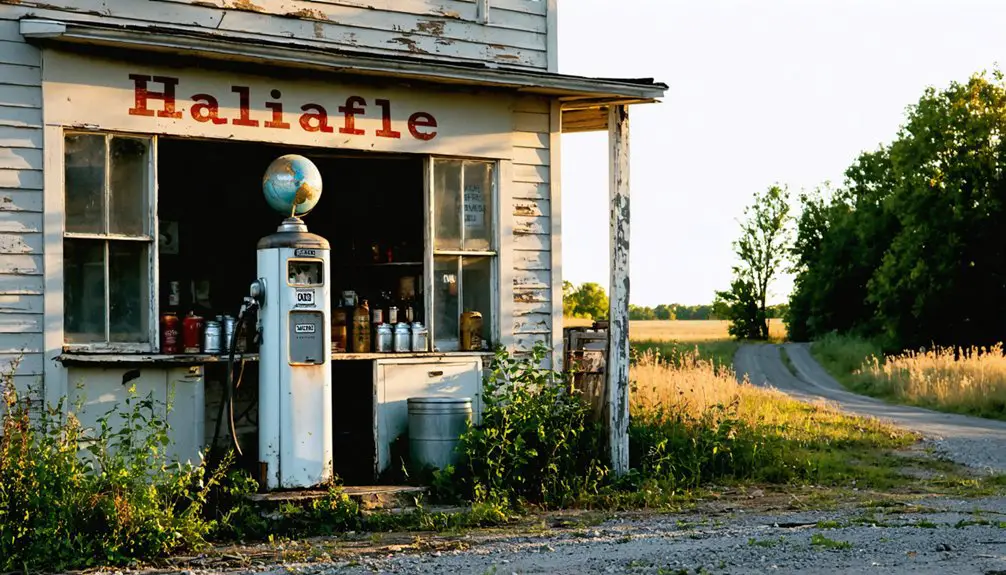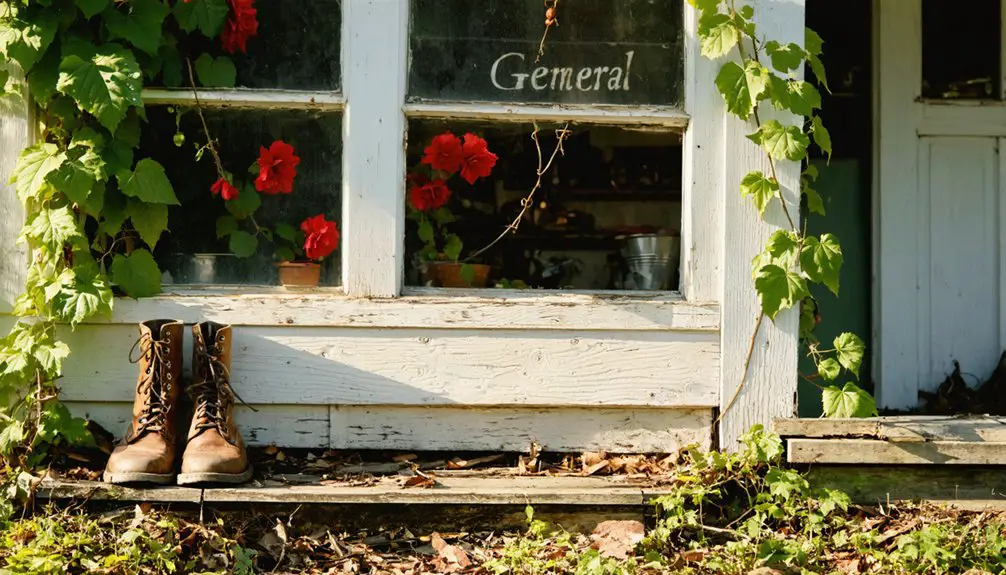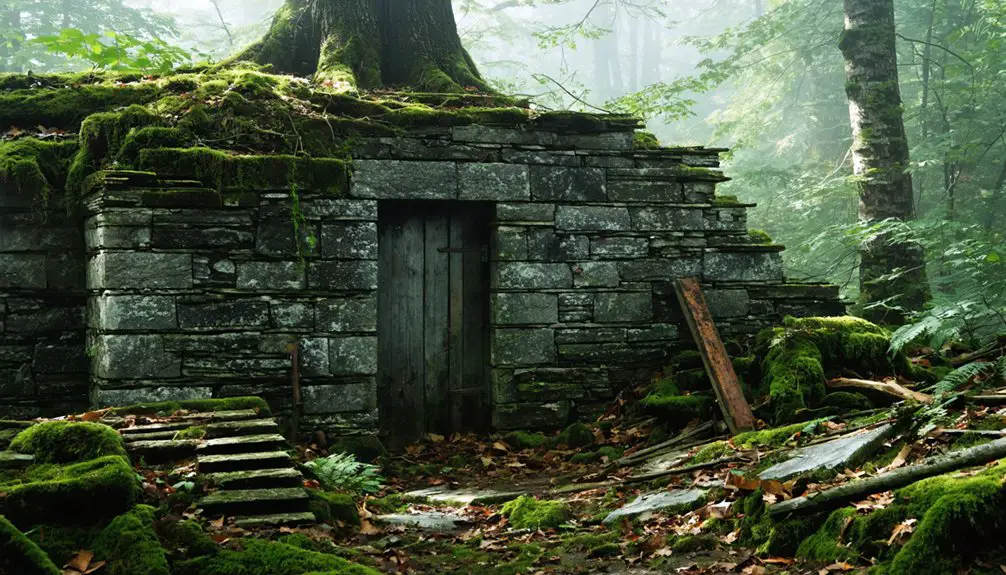You won’t find Halifax, Vermont on any ghost town lists – it’s actually one of Vermont’s continuously inhabited communities since its 1750 charter. While nearby towns like Glastenbury became abandoned, Halifax maintained its population through challenging times, from four families in 1766 to today’s 771 residents. Despite economic shifts and population fluctuations, including a peak of 1,758 in 1810, this rural town’s rich heritage and active community life tell a fascinating story of survival.
Key Takeaways
- Halifax, Vermont is not a ghost town, having maintained continuous habitation since its founding in 1750 under Governor Benning Wentworth’s charter.
- Unlike nearby ghost town Glastenbury, Halifax has sustained its population, currently at 767 residents, ranking 202nd among Vermont’s 277 towns.
- The town experienced significant population fluctuations, peaking at 1,758 in 1810 and dropping to 268 by 1960, but rebounded afterward.
- Despite historical economic challenges and out-migration between 1850-1900, Halifax maintained its community with active social centers and preserved landmarks.
- The town currently demonstrates stability with a median household income of $81,826 and 2.7% unemployment rate, showing resilience against ghost town fate.
Setting the Historical Record Straight
While some Vermont communities have earned the “ghost town” designation due to dramatic population losses and mysterious abandonments, Halifax stands apart as a town that has maintained continuous habitation since its 1750 charter.
Unlike Glastenbury, which experienced mysterious disappearances and eventual disincorporation, Halifax’s population changes reflect typical rural economic shifts rather than catastrophic events. The stark contrast is evident as Glastenbury’s population peaked at only 241 residents before its decline. The town’s early development was initiated by Abner RICE who began settlement in 1761.
You’ll find evidence of sustained town governance and civic engagement throughout Halifax’s history, with active essential records documenting births, deaths, and marriages well into the 1900s.
The town’s peak population of 1,700 in the early 20th century demonstrates its status as a small but vibrant rural community.
Today, Halifax continues to operate from its town office on Branch Road, maintaining its administrative functions and community presence.
Colonial Roots and Early Settlement
You’ll find Halifax’s colonial roots firmly planted in Benning Wentworth’s May 11, 1750 charter, which granted a 6-by-6-mile territory divided into 62 lots of 360 acres each.
The earliest pioneers faced the formidable task of establishing homes in 1751, with each settler receiving both a main lot and a one-acre defensive town lot near the settlement’s center.
Despite initial concerns about Native American hostilities, Halifax’s settlers succeeded in building a sustainable community, benefiting from the relative security of their location compared to other frontier settlements of the era.
Origins Under Wentworth’s Charter
As part of New Hampshire’s territorial expansion in the 1750s, Governor Benning Wentworth chartered Halifax, Vermont on May 11, 1750. The charter’s significance extended beyond mere land distribution, as it represented a strategic move to assert New Hampshire’s dominance amid intense territorial competition with New York and Massachusetts.
You’ll find that the charter granted specific land boundaries to proprietors who were tasked with recruiting settlers and organizing development. Similar to the approach taken by John Wentworth in establishing Dartmouth College’s charter, these land grants were designed to stimulate economic growth and settlement.
While settlement began in 1751, your ancestors faced significant challenges from Indigenous resistance and the French and Indian War. These conflicts often forced abandonment of settlements until peace was achieved in 1760. The western Abenaki population of ten thousand in 1600 had long occupied these territories before European settlement began.
The charter served as a legal framework that legitimized British claims in the contested frontier lands while establishing governance structures for the emerging township under colonial law.
Pioneering Settlers Forge Community
Despite the promising land grant of 1750, Halifax’s early settlement proved treacherous as pioneering families confronted persistent threats from Native American resistance and the broader French and Indian War.
Similar to how Saint Croix Island was established by French settlers in 1604, Halifax represented another daring colonial frontier settlement venture.
The French employed Native American raiding parties to disrupt English settlement expansion in the region.
You’ll find that settler cooperation became essential for survival, as evidenced by the tragic death of Matthew during the conflicts.
While French influence from Lake Champlain complicated regional stability, determined English colonists from New England persisted in their settlement efforts.
Rice Leads Initial Migration
The Rice family spearheaded Halifax’s essential settlement movement following Governor Benning Wentworth’s 1750 charter of the territory. Under Rice leadership, settlers faced intense migration challenges during the French and Indian War, which initially forced them to abandon their settlement attempts around 1751.
You’ll find that after 1760, when hostilities finally eased, the Rice family led a resurgence of settlement efforts that helped establish Halifax’s foundational community structures.
- The Rice migration embodied the spirit of New England families seeking independence and fertile lands beyond the settled frontiers.
- Their perseverance through Native American conflicts demonstrated the determination required for frontier settlement.
- They brought crucial Puritan values and community organization practices that shaped Halifax’s early development.
- Their leadership in post-war settlement laid groundwork for the region’s agricultural economy and population growth.
By 1761, the settlers established their permanent roots in the elevated township, taking advantage of the area’s favorable terrain for agriculture.
Natural Landscape and Geographic Appeal
Located in southern Vermont’s Windham County, Halifax spans nearly 40 square miles of diverse terrain characterized by gently rounded hills and dramatic river valleys.
You’ll discover remarkable natural beauty along the Green River and East Branch of the North River, where rugged walls form scenic gorges that cut through the landscape.
While exploring the area, you’ll find Woodard’s Cave, a 25-foot cavern that adds intrigue to the North River’s course.
The town’s dense forest cover, consisting mainly of mixed hardwoods, has reclaimed much of the former farmland through second and third growth.
These wilderness areas create perfect conditions for hiking, bird watching, and photography, while the rivers enhance the region’s appeal with their deep valleys and diverse aquatic habitats.
Similar to the winding rivers found throughout southern Lake Champlain, the waterways carve through scenic countryside and rolling farmland.
The area’s distinct features make it one of several notable locations sharing the name Halifax across North America.
Economic Evolution Through Time

Originally granted to proprietors from Massachusetts and New Hampshire, Halifax exemplified the speculative nature of colonial land development, where many initial owners viewed their grants more as investments than settlements.
The town’s economic transformation followed Vermont’s typical pattern, starting with small-scale agriculture before facing significant transportation impact when railroads arrived in the mid-1800s. Many residents engaged in subsistence farming practices to feed their families and maintain basic self-sufficiency. While rail access initially promised prosperity, it ultimately contributed to Halifax’s decline by flooding markets with cheap western goods that local farmers couldn’t compete against.
- Resource-based industries like quarrying created temporary booms but left the town vulnerable to market shifts.
- Out-migration from 1850-1900s steadily eroded the town’s economic foundation.
- Rail infrastructure decisions directly influenced the town’s fate.
- Economic isolation, combined with population loss, accelerated the town’s decline.
Life in Halifax vs. Vermont’s Abandoned Towns
Unlike Vermont’s ghost towns that failed to maintain viable populations, Halifax demonstrated remarkable stability by growing from just four families in 1766 to approximately 140 freemen by 1778.
You’ll find that while abandoned towns like Glastenbury struggled to break triple-digit populations before their demise, Halifax established lasting community structures including blockhouses, farms, and essential administrative offices.
The town’s enduring legacy is evident in its continuous record-keeping and maintained infrastructure, setting it apart from Vermont’s numerous abandoned settlements that lost their economic base and community cohesion.
Population Stability vs. Decline
While many Vermont towns have completely disappeared into ghost town status, Halifax maintains a modest but stable population that distinguishes it from abandoned communities.
You’ll find the town’s population dynamics reflect resilience, even with its decline from a peak of 832 in 2009. Halifax’s rural stability is demonstrated by its current population of 767, ranking 202nd among Vermont’s 277 towns.
- Despite historical declines from the 1820s through 1960, Halifax hasn’t followed the path of Vermont’s ghost towns
- The town’s 5.94% population growth from 2013-2023 shows recovery potential
- A median household income of $62,333 supports continued community viability
- Halifax’s demographic mix and median age of 41.1 years suggests sustainable population patterns
Community Legacy Still Thrives
Halifax stands as a representation of Vermont’s enduring community spirit, sharply contrasting with the state’s numerous abandoned settlements. While many Vermont ghost towns have succumbed to decay, you’ll find Halifax actively preserving its rich heritage dating back to 1750 through cultural preservation and community engagement.
Unlike abandoned towns that have lost their historical narratives, Halifax’s legacy thrives through its Historical Society‘s documented volumes, preserved architecture, and maintained historical roads like “The Great Road.”
You’ll witness how the town balances growth with preservation through regular town planning meetings, where you can participate in shaping the community’s future. The preserved chimney of Dr. Edward Niles’ summer hotel and other historical landmarks serve as tangible links to the past, ensuring Halifax’s cultural identity remains vibrant and accessible.
Cultural Heritage and Community Bonds

Throughout generations of settlement, the cultural fabric of this Vermont community has been woven through strong family lineages and cherished gathering spaces.
You’ll find this heritage preserved in the Halifax Community Hall, transformed from an 1844 church into a vibrant social center. The hall continues to host cultural events from weddings to memorial services, while the new Halifax Cafe creates opportunities for weekly community gatherings.
This commitment to preserving traditions stems from the town’s diverse New England settler roots.
- Family names like Taggetts, Wilcox, and Thomas anchor multigenerational bonds
- Educational institutions historically shaped community identity through arts and higher learning
- Traditional customs flourish through shared celebrations and civic engagement
- Adaptive reuse of historic structures maintains cultural continuity while embracing change
Demographic Patterns and Population Changes
As settlement patterns shifted across New England in the early 1800s, Halifax experienced dramatic population fluctuations that would define its demographic story.
You’ll find that after reaching its peak of 1,758 residents in 1810, the town faced persistent demographic shifts, dropping to just 268 people by 1960. While many Vermont ghost towns completely vanished, Halifax showed remarkable population resilience, rebounding to 782 residents by 2000.
Halifax defied Vermont’s ghost town fate, bouncing back from just 268 residents in 1960 to a thriving community of 782 by 2000.
Today, you’ll see a stable community of about 771 people, though projections suggest a slight decline to 759 by 2025. The town’s population maintains its rural character with a median age of 41 and an average household income of $81,826.
Unlike some abandoned Vermont towns, Halifax’s continued habitation proves its enduring appeal despite historical challenges.
Survival Against the Odds
When faced with seemingly insurmountable challenges in the 1750s, the early settlers of what would become Halifax demonstrated remarkable tenacity against hostile conditions. Their resilience strategies included adapting to harsh terrain, establishing sustainable agriculture, and building strong community bonds.
You’ll find that Halifax’s community survival hinged on their ability to overcome natural disasters, including a devastating tornado in 1788, while maintaining essential township functions through their clerk’s office.
- Developed diverse economic activities to guarantee sustainability despite geographic isolation
- Created robust record-keeping systems that preserved community continuity
- Established peaceful relations with Indigenous peoples after initial conflicts
- Built self-reliant social structures that helped weather environmental and economic challenges
Through these adaptations, Halifax’s inhabitants proved that determined communities could persist against formidable odds in early New England.
Modern Day Halifax: A Living Legacy
Despite its modest population of 767 residents, modern-day Halifax maintains a vibrant legacy as a quintessential Vermont rural community.
You’ll find a tight-knit population displaying modern resilience through stable employment, with only 2.7% unemployment, and median household incomes reaching $62,333.
The community spirit shines through Halifax’s diverse makeup, where 82.5% white residents and 14-15% multiracial citizens create a uniquely blended small-town atmosphere.
While the population shows a slight annual decline of 0.5%, the town’s mature demographic, with a median age of 41.1 years, contributes to its stability.
Though some residents face economic challenges, with 5-7% living below the poverty line, Halifax’s mixed household structures and relatively low poverty rates compared to surrounding areas demonstrate its continued adaptability in rural Vermont.
Frequently Asked Questions
What Supernatural Legends or Mysteries Exist Specifically in Halifax’s History?
Between a rock and a hard place, you won’t find documented haunted legends or ghost sightings here – just regional folklore influenced by nearby Glastenbury’s supernatural tales and early settler conflicts.
How Did Native American Tribes Interact With Halifax’s Early Settlers?
You’ll find that local Abenaki tribes maintained surprisingly peaceful relations with Halifax settlers, engaging in tribal diplomacy through fur trading and cultural exchange, despite earlier regional tensions and defensive preparations.
What Was Halifax’s Role During the American Revolutionary War?
You’ll find Halifax’s Revolutionary War role centered on local leaders organizing town meetings by 1778, showing military significance through supporting Vermont’s constitution and contributing to broader Patriot militia efforts in New England.
Were There Any Significant Natural Disasters That Impacted Halifax’s Development?
You won’t find records of flood impact or earthquake aftermath affecting the town’s development. Historical documents show no major natural disasters disrupted settlement patterns or contributed to the area’s eventual decline.
What Traditional Festivals or Annual Celebrations Were Unique to Halifax?
You won’t find any festivals unique to Halifax, as historical records don’t show distinct celebrations. While the Community Hall hosted typical New England gatherings after 1952, they weren’t specific to Halifax’s identity.
References
- http://sites.rootsweb.com/~vtwindha/vhg5/vt_gazetteer-halifax.htm
- https://www.youtube.com/watch?v=ScW-H7A8yL8
- https://deerfieldvalleyrealestate.com/area-resources/town-information/halifax/
- https://www.barnesandnoble.com/w/glastenbury-resch/1114029021
- https://en.wikipedia.org/wiki/List_of_ghost_towns_in_Vermont
- https://www.familysearch.org/en/wiki/Halifax
- https://www.thetravel.com/glastenbury-mountain-ghost-town-history-vermont/
- http://freepages.rootsweb.com/~gtusa/history/usa/vt.htm
- https://en.wikipedia.org/wiki/Halifax
- https://familyhistory.lib.byu.edu/00000191-33c5-d3bf-a393-bff7494d0001/vermont-pdf



